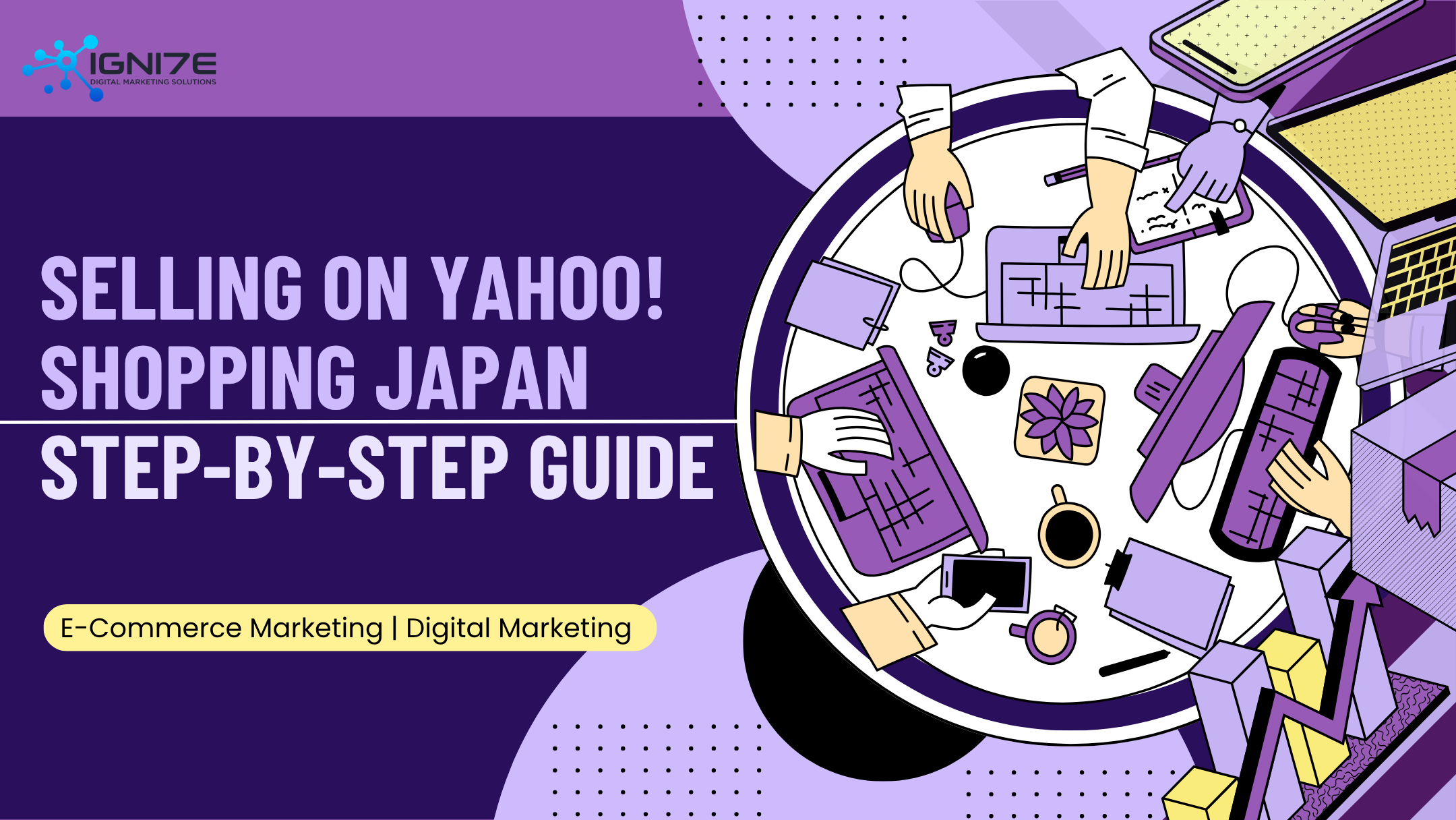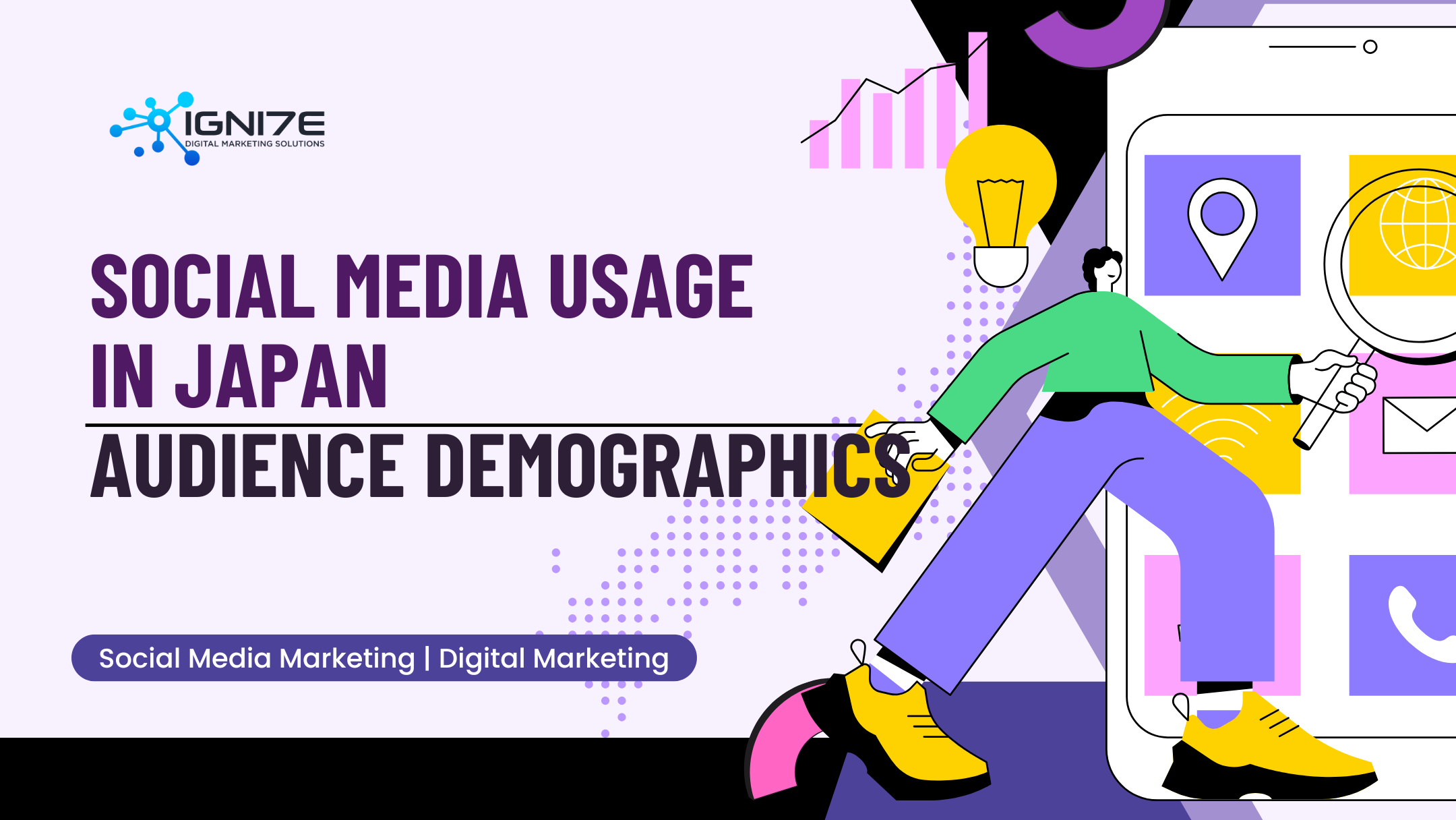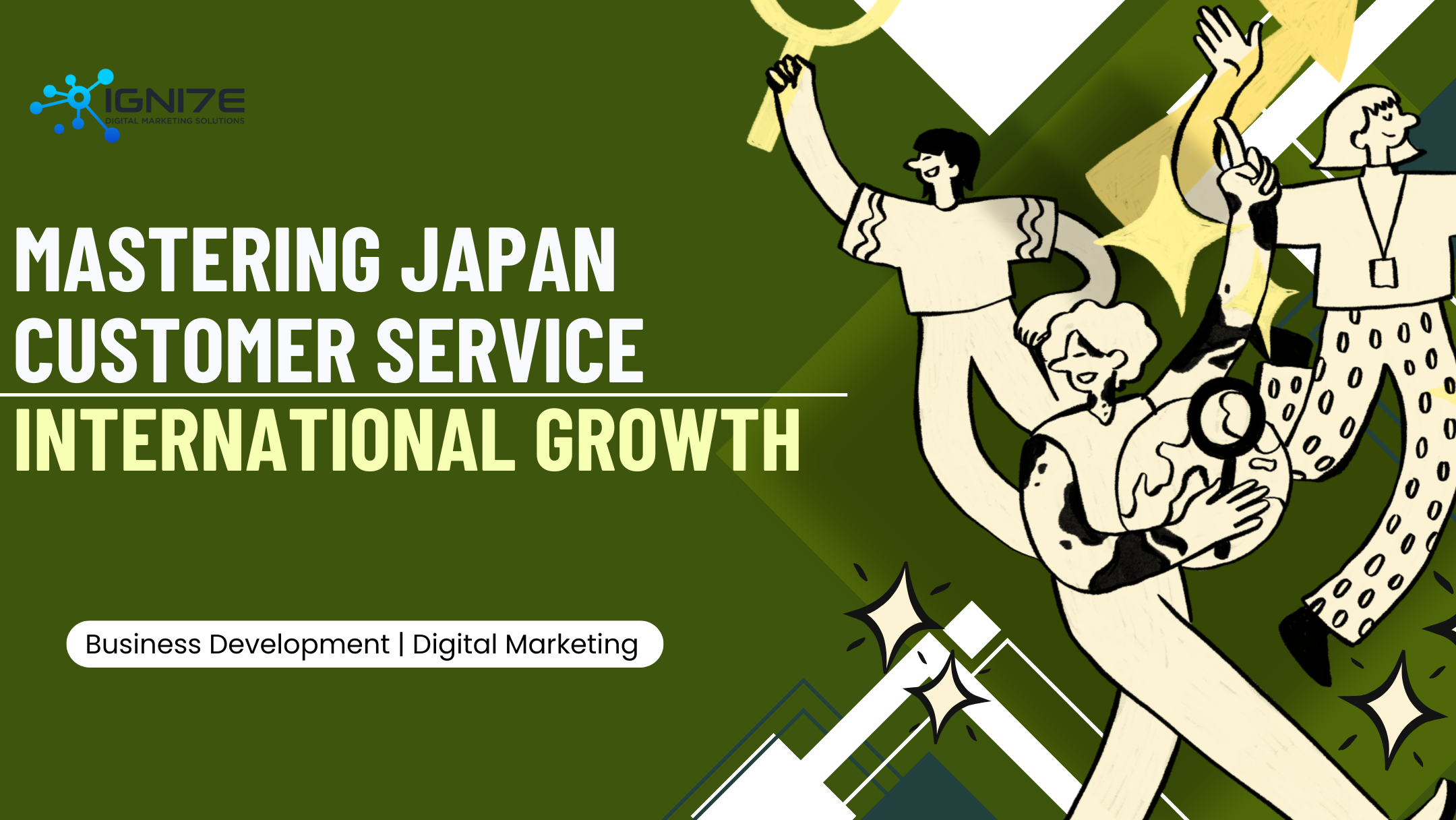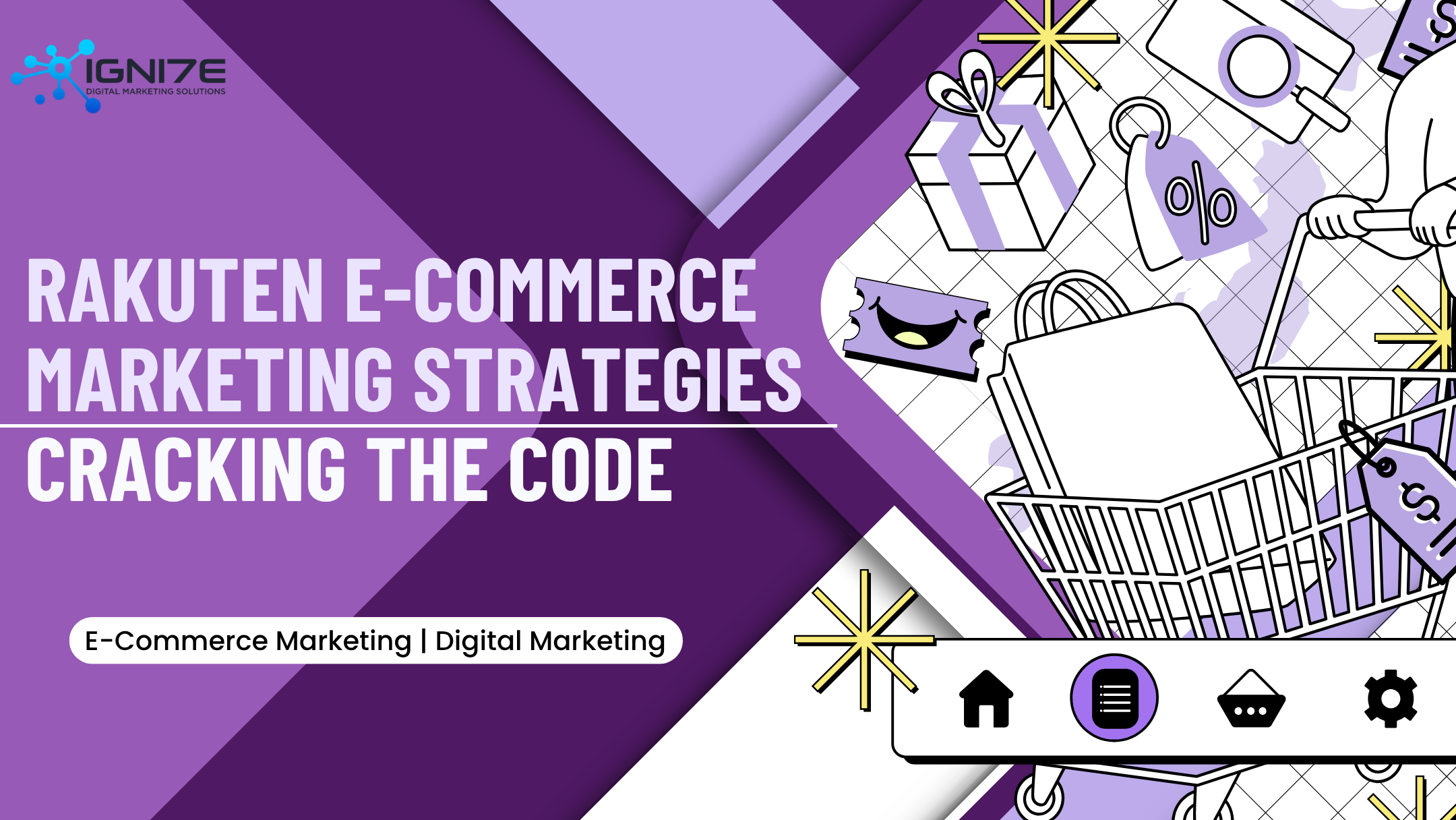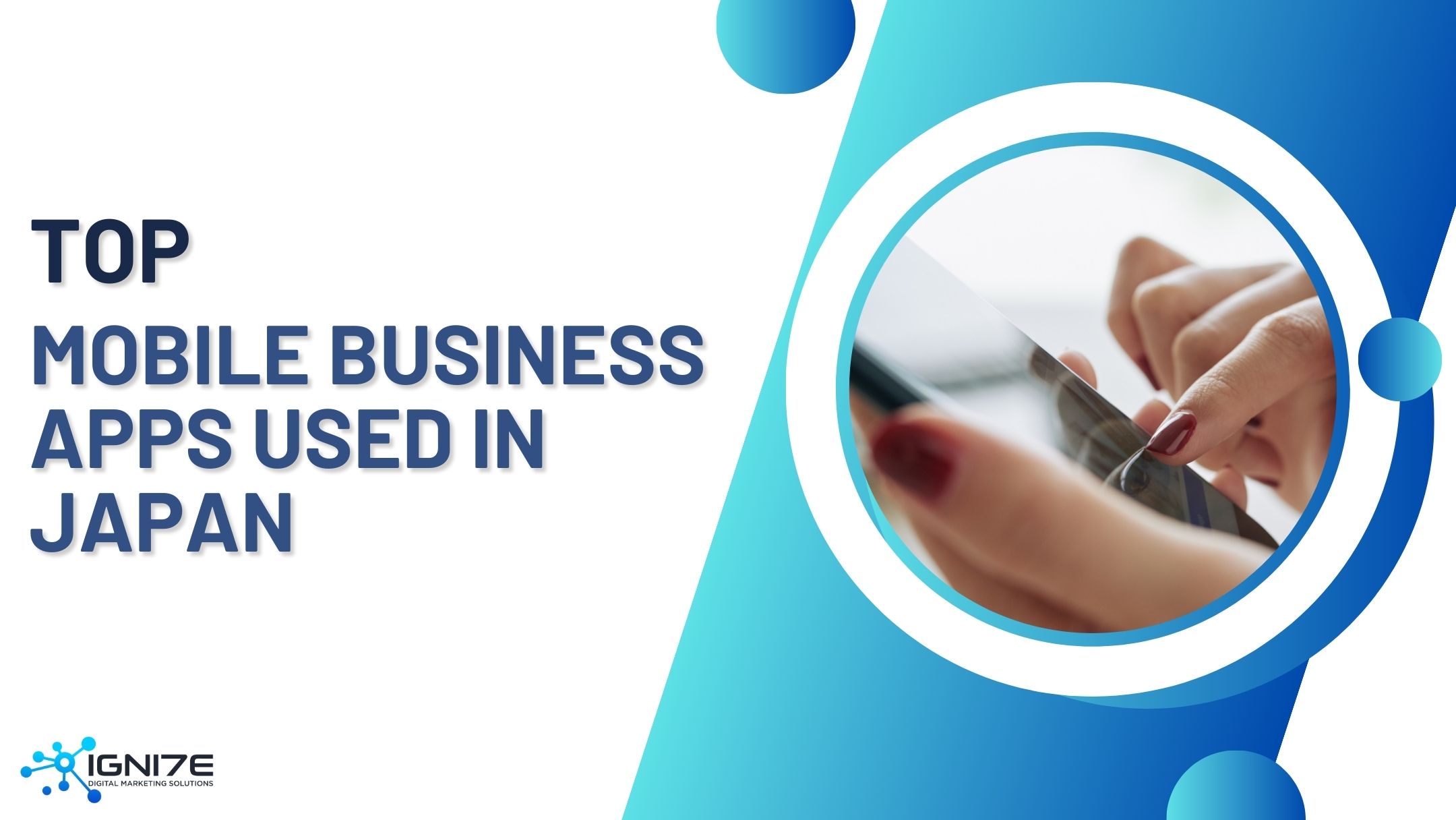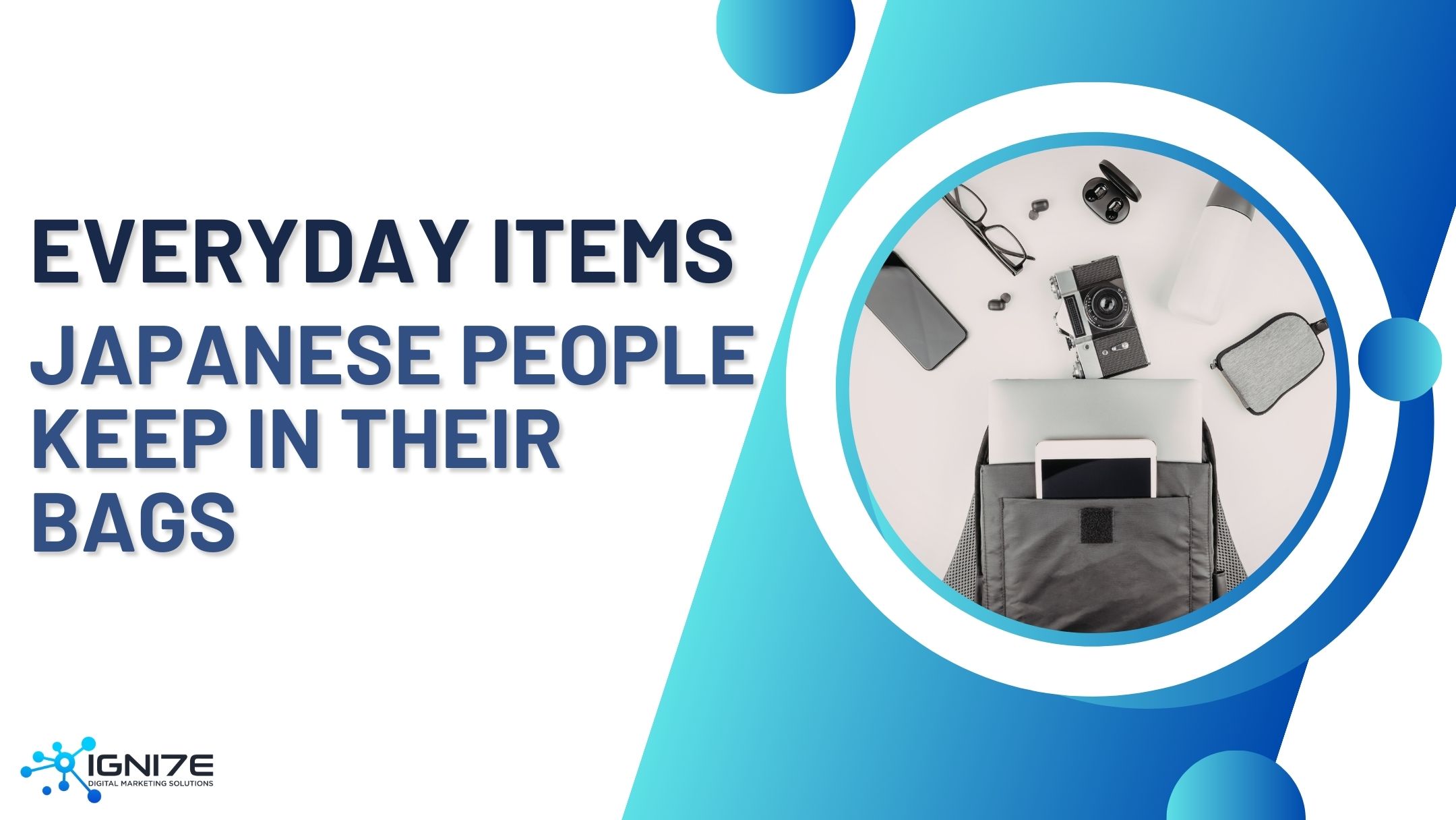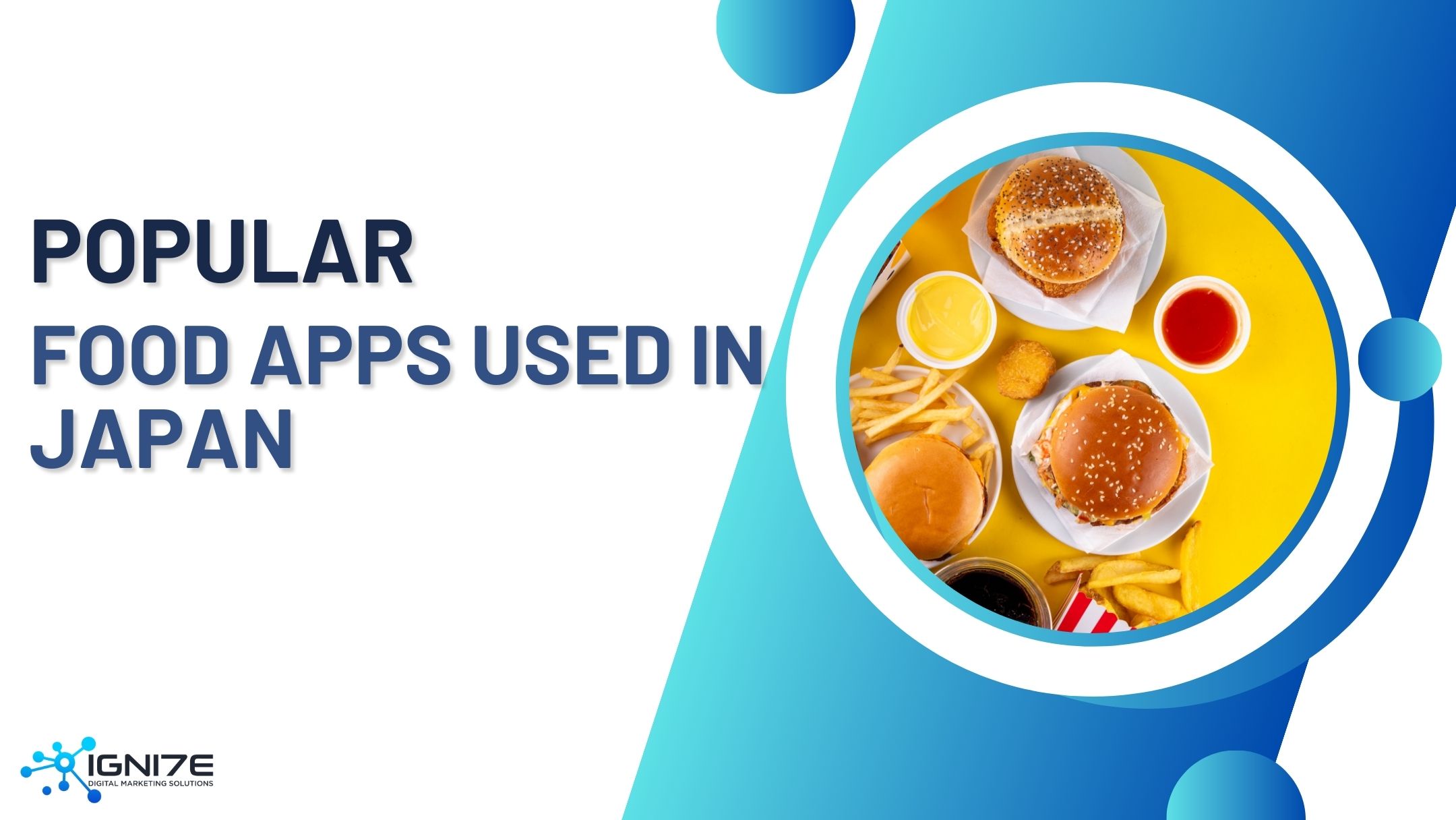From Translation to Innovation: Why Japanese Copywriting Matters for Global Brands
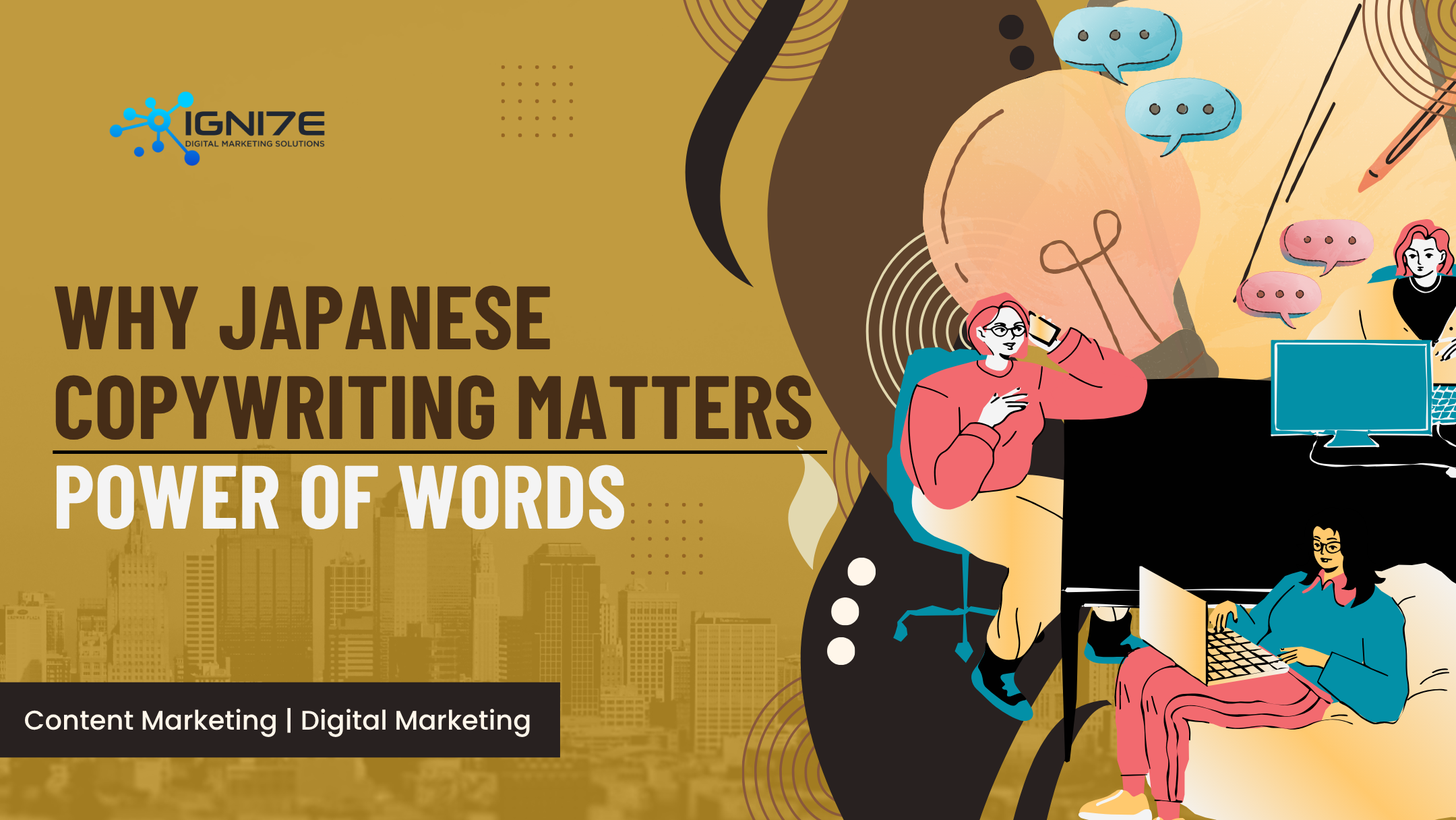
Entering the Japanese market requires more than just translating existing content; it demands mastering Japanese copywriting. Understanding cultural nuances, effective localization, and strategic copywriting is crucial for foreign companies. Whether you're launching a new venture or expanding an existing one, starting a business in Japan means aligning every aspect—from legal setup to brand voice—with local expectations. This article explores essential insights, from the impact of Japanese culture on marketing to the importance of specialized team roles. By leveraging these strategies, your business can achieve better visibility, brand awareness, and sales in Japan. Discover how consultants can help you navigate the complex landscape and succeed in the Japanese market.
Copywriting in Japan

Copywriting in Japan is essential for foreign companies seeking to impact their unique and competitive market significantly. Japanese consumers value authenticity, precision, and cultural relevance in the content they engage with. Therefore, Japanese copywriting goes beyond simple translation; it requires a thorough understanding of local customs, cultural nuances, and consumer preferences. Effective copywriting in Japanese helps brands connect with their audience on a deeper level, fostering trust and loyalty. By mastering the art of copywriting in Japan, foreign companies can enhance their brand visibility, build stronger customer relationships, and ultimately achieve greater success in the Japanese market.
What Is Copywriting and Why Is It Crucial for Foreign Companies?
Copywriting in Japan involves crafting persuasive, engaging, and culturally relevant content tailored to Japanese consumers. For foreign companies, mastering Japanese copywriting is crucial for several reasons.
First, it enhances visibility. Well-written copy that resonates with the local audience ensures your brand stands out in a crowded marketplace. By using precise language and culturally appropriate references, your content is more likely to capture the attention of potential customers.
Second, effective copywriting in Japanese significantly boosts brand awareness. When your content aligns with Japanese consumers' cultural expectations and values, it helps build a strong and recognizable brand presence. Consistent and culturally sensitive messaging fosters trust and loyalty among your target audience.
Finally, it powerfully increases sales. A persuasive and well-crafted copy can drive consumer action, encouraging purchases and improving conversion rates. Your content can effectively motivate Japanese customers to choose your products or services over competitors by addressing their specific needs and preferences.
Types of Copywriting
Japanese copywriting encompasses various forms of content tailored to different marketing needs. Each type is crucial in effectively reaching and engaging the target audience. Media buying in Japan often works hand-in-hand with copywriting, as culturally attuned messaging is essential to ensure ad placements resonate with local consumers.
By mastering these diverse forms of copywriting in Japan, foreign companies can effectively engage their audiences and successfully achieve their marketing objectives. In today’s digital landscape, social media plays a critical role in shaping brand perception, and influencer marketing has become a powerful tool for building trust and driving consumer behavior—especially when aligned with culturally relevant messaging.
Optimize Your Website for a Japanese Audience
Even the most compelling copy can lose its impact if it's not presented within a culturally attuned user experience. Website layout, tone of voice, choice of visuals, and even button text all influence how Japanese users interact with your brand online. Localization isn't just about language—it’s about creating a seamless experience that feels native to Japanese visitors.
To truly resonate with local consumers, businesses need more than translation—they need a strategic content and UX approach tailored to Japan’s unique digital landscape.
Ready to make your website work in Japan?
Our guide, Optimizing Your Website for a Japanese Audience, teaches you how to optimize your content and design for Japanese users.
Why Action-Based Copywriting in Japan Is Not Just Translation
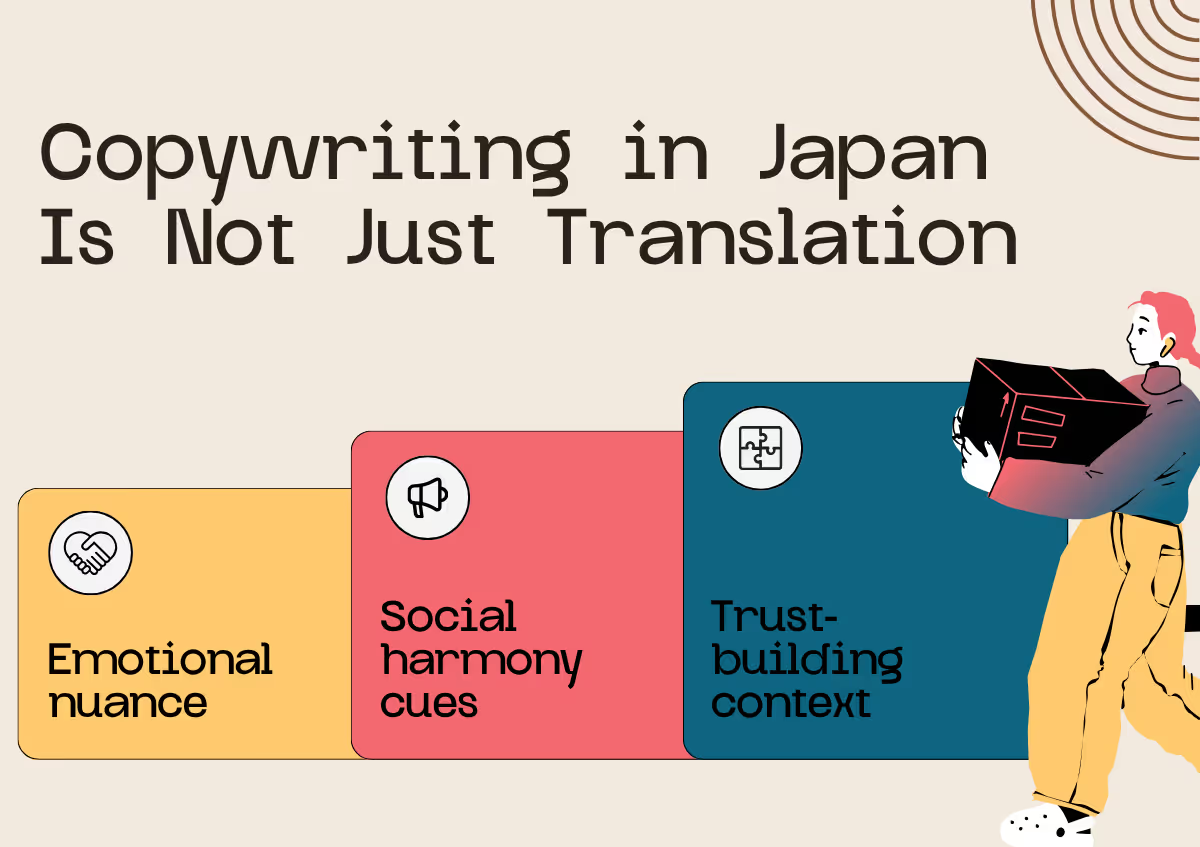
For foreign companies entering Japan, it can be tempting to treat copywriting as a simple translation task—taking what works in English, converting it to Japanese, and expecting similar results. However, that method almost always falls short.
Japanese copywriting goes far beyond translating words. It involves reshaping the message to fit cultural norms, meet reader expectations, and resonate with the psychology of Japanese consumers. Action-oriented copy—designed to drive user behavior such as clicking a button, filling out a form, or making a purchase—is where these differences become especially critical.
In Japan, getting someone to act requires more than a strong call to action. It demands:
- Emotional nuance (感情の機微)
- Social harmony cues (e.g., indirect suggestions rather than direct commands)
- Trust-building context before asking for anything
While translation ensures that the words are accurate, it often strips away the persuasive structure that makes copy effective in Japanese. A good Japanese copywriter doesn’t ask: “How do I say this in Japanese?” They ask: “How would a Japanese person need to hear this in order to act?”
For example:
Western copy might push: “Sign up now and get 25% off.”
Japanese copy will reframe: 「今なら、初回限定25%オフでお試しいただけます。」
(“For a limited time, first-time users can try it with 25% off.”)
Both convey the same offer, but only one feels appropriate to a Japanese audience.
Japanese users often need more context before acting. They’re risk-averse, detail-oriented, and responsive to messaging that shows understanding of their situation or role (especially in B2B or SME environments). Effective Japanese copywriting requires restructuring the message, not just translating it.
If you simply translate your English content:
- CTAs become too aggressive
- Benefits are buried in vague or flat language
- Trust and emotional resonance are lost
But when you rewrite based on Japanese reading behavior, tone, and cultural cues, the same content becomes engaging, polite, and persuasive, ultimately driving better results.
Japanese Copywriting vs. Western Copywriting: The Core Differences
Understanding the differences between Western and Japanese copywriting is critical if you want your message to convert, not just be understood. Western copy tends to be built around clarity, brevity, and strong calls to action. In contrast, Japanese copywriting emphasizes politeness, indirectness, emotional assurance, and social harmony.
Here are the core differences that directly impact how your copy should be written:
- Tone and Directness
Western: Straight to the point. Strong CTAs like “Buy now,” “Start your free trial,” or “Don’t miss out!” are common.
Japanese: More indirect and respectful. You’ll often see softer phrasing like:
- 「ご検討ください」 (Please consider…)
- 「まずはお気軽にご相談ください」 (Feel free to contact us to start)
A direct command in Japanese can feel abrupt or even rude. Instead of pushing, the Japanese copy invites and reassures.
- Structure and Flow
Western: Often follows AIDA (Attention, Interest, Desire, Action) or PAS (Problem-Agitate-Solution) frameworks.
Japanese: Similar frameworks can be applied, but they must be softened with contextual buildup and social proof (e.g., customer count, testimonials, trust badges). Flow is more circular than linear, with subtle transitions that feel natural.
In the Japanese copy, don’t jump straight into the ask. Build trust first with shared concerns, results, or empathy.
- Emotional Triggers
Western: FOMO (fear of missing out), scarcity, urgency.
Japanese: Security, community, responsibility. Consumers want to feel reassured and socially aligned, not pressured.
For example:
- English: “Only 3 left in stock—order now!”
- Japanese: 「ご好評につき、残りわずかです。」 (Due to popularity, only a few remain.)
Same meaning, but framed with respect and implied demand, not desperation.
- Language Density
Western: One sentence = one idea.
Japanese: One sentence often implies multiple layers of meaning, with fewer words.
This means translated copy is often shorter in Japanese but less effective unless rebuilt with the proper emotional cues and value explanation.
Why Translation Shrinks Copy and What That Means for Foreign Companies
Japanese and English operate under different rules of grammar and logic. In Japanese, it’s common to omit the subject, use contextual cues instead of explicit phrasing, and rely heavily on implied meaning. The result: translated copy often ends up shorter, but also emptier.
Many foreign companies go wrong here. By simply translating English copy line-by-line, they unknowingly remove crucial context and emotional weight, both essential for effective marketing in Japan.
What gets lost in translation:
- Subjects and pronouns (e.g., “you” or “your team”) often disappear.
- Tone and warmth are reduced unless consciously rebuilt.
- Calls to action can feel abrupt or unnatural if directly translated.
The key is: Don’t translate — reconstruct.
Effective Japanese copywriting isn’t about linguistic accuracy, functional clarity, and emotional flow. You should rebuild your message around how Japanese users process and respond to information. That means:
- Use benefit-first structures (ベネフィット先行型)
- Avoid passive voice and overly descriptive sentences
- Add context through natural questions, idiomatic phrasing, or soft social proof
Example:
Original English: “Our software helps small businesses automate their invoicing.”
Bad Japanese translation: 「私たちのソフトは中小企業の請求書作成を自動化します。」
Effective Japanese copy:
「毎月の請求書作成が、もっとカンタンに。中小企業向け自動化ツール。」
The revised Japanese version leads with the outcome and speaks directly to the reader’s problem. It transforms an introductory statement into a copy block that drives interest and action.
The Real Role of Copywriting for Japanese SMEs
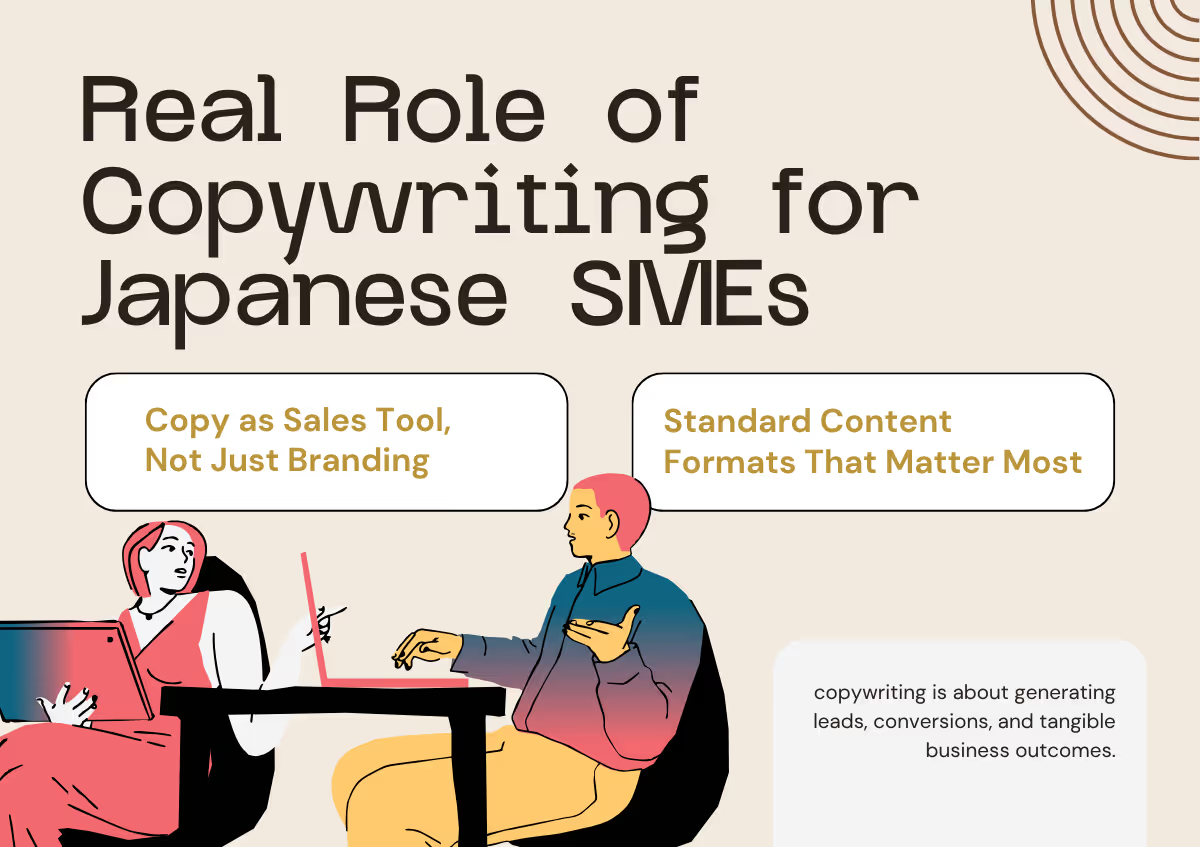
For small and mid-sized businesses (中小企業) in Japan, copywriting isn’t just about expressing brand values—it’s about generating leads, conversions, and tangible business outcomes.
Unlike large corporations with the resources for long-term branding campaigns, SMEs require copy that delivers immediate results—landing pages that generate inquiries, LINE messages that prompt clicks, and email sales letters that lead to bookings. In such a context, copywriting needs to serve as a direct-response sales tool rather than simply expressing brand identity.
Foreign companies entering Japan must rethink their content strategy accordingly. The goal isn’t to sound “fluent in Japanese”—it’s to write in a way that makes Japanese customers act.
Copy as Sales Tool, Not Just Branding
In Japan, your website is more than just an online brochure—it’s your virtual storefront, and your copy is the salesperson. A good copy doesn't simply describe what you do; it guides the customer to why it matters to them and gives them a culturally appropriate way to take the next step.
Bad Example (Feature-Focused Copy):
「私たちは最高の家を作ります。」
(We build the best homes.)
Too vague. Focuses on the company, not the user. Offers no benefit or action.
Better Example (Benefit + Emotional Hook):
「家族と過ごす毎日が、もっと快適になるリフォームをご提案します。」
(We offer renovations that make everyday life with your family more comfortable.)
Shows empathy, highlights the outcome, and speaks directly to the user’s lifestyle.
Effective Japanese copywriting for SMEs is about leading with the benefit and guiding the reader to a soft close, such as a contact form or consultation request.
Standard Content Formats That Matter Most
To reach Japanese consumers, especially as a foreign business, you must excel at the formats where action happens. Here are the most critical ones for SMEs and how to approach them:
Landing Pages
Should be structured with benefits, followed by proof, trust elements, and a gentle CTA.
Start with a clear emotional value:
「請求書処理の時間を、1日30分短縮しませんか?」
(What if you could save 30 minutes a day on invoicing?)
LINE Ads & Social Posts
Short, polite, and value-driven.
「今すぐ使える業務効率化のヒントを、LINEでお届けしています。」
(We send helpful business tips straight to LINE.)
Product Pages
Focus on what the product helps the user achieve, not just specs.
「このツールで、見積もり作成のミスがゼロに。」
(Eliminate errors in your quotation workflow with this tool.)
Email Sales Letters
Use 丁寧語 and a soft action invitation:
「ご興味がございましたら、ぜひ一度ご相談ください。」
(If this interests your business, we’d be happy to discuss further.)
What Makes These Formats Work in Japan?
- Benefit-First Messaging (ベネフィット先行型)
Don't start with who you are. Start with what the customer gains.
Bad: 「当社の製品は…」 (Our product is...)
Better: 「導入するだけで、毎月の経費を10%削減。」 (Cut monthly expenses by 10% with one simple tool.)
- Trust-Building Language (丁寧語 + 実績)
Japanese readers look for professionalism and social proof. Include:
- 実績 (proof): 「導入企業数500社以上」
- 評価 (testimonials): 「多くのお客様から高評価をいただいています」
- 専門性: Highlight if your team has certifications or Japan-specific experience
- Soft Close CTAs
Instead of “Buy now,” use:
- 「お気軽にご相談ください」 (Feel free to contact us)
- 「まずは資料をご覧ください」 (Please start by reviewing our materials)
- 「無料でお試しいただけます」 (You can try it for free)
These phrases remove pressure while gently guiding the user to act.
Anatomy of High-Converting Japanese Copywriting

High-performing Japanese copywriting doesn’t just sound good—it moves people to take action in a way that feels natural, trustworthy, and culturally appropriate. It’s not about flashy slogans or clever wordplay. It’s about clarity, logic, structure, and emotional alignment.
In a culture that values subtlety and order, copy must guide readers through a smooth, respectful journey. Japanese consumers respond best to messaging that builds context and trust before inviting any commitment—an approach especially important in B2B, SaaS, and service-based sectors where skepticism is common and competition is fierce.
The distinct cultural landscape in Japan also means that link building strategies must be adapted to fit local expectations and business practices, which differ significantly from Western approaches.
Want to dive deeper? Read our comprehensive marketing guide to discover how to craft culturally tailored copy and effective link building and SEO strategies that truly resonate with Japanese audiences.
Sentence Flow: The “Japanese Line” Principle
If you’ve ever stood in a perfectly formed line at a Japanese train station, you’ve already seen how excellent Japanese copy should work.
Think of your copy as a queue:
- Each sentence has a clear place
- Every phrase builds gently into the next
- Nothing disrupts the rhythm
- The reader always knows what’s coming and why
This is what we call the “Japanese Line” Principle:
Sentences should flow with precision, logical, frictionless, and purposeful.
This mirrors Joseph Sugarman’s famous “slippery slope” principle, where each sentence exists to get the reader to read the next. But in Japanese, this flow must feel polite and effortless, not pushy.
Example text: Automate your tasks with our tool. Download now!
English-style translation:
「このツールであなたの業務を自動化します。今すぐダウンロードしてください!」
(This tool will automate your tasks. Download now!)
Abrupt. Rushed. The tone doesn’t match local expectations.
Japanese-style flow:
「毎日の業務に、もっと余裕を。自動化ツールで、時間とコストを削減しませんか?」
(Create more breathing room in your daily workflow. Save time and costs with our automation tool.)
Smooth. Value-first. The message flows toward a soft, persuasive next step.
Headline Structure for Action-Based Copy
Headlines are often the first and only thing a reader sees. In Japan, where users scan quickly and expect immediate clarity, your headline must deliver three things at once:
Formula: [Benefit] + [ターゲット明示 (target audience)] + [信頼構築 (credibility signal)]
This structure delivers what matters most to the Japanese reader:
- What’s in it for me?
- Is it for someone like me?
- Can I trust this?
Example:
「忙しい中小企業のための、手間いらず請求書管理ツール」
(An effortless invoicing tool—designed for busy SMEs)
Breakdown:
- Benefit: 手間いらず請求書管理 (effortless invoicing)
- Target audience: 忙しい中小企業のため (for busy SMEs)
- Trust/Credibility: Implied through clarity, structure, and solution-based phrasing
You don’t need to be clever—you need to be transparent and customer-focused.
Additionally, try to avoid vague or abstract phrases like 「最先端のソリューション」 (cutting-edge solutions)—too corporate and empty.
Use specifics:
- 「30分の作業時間を短縮」 (Save 30 minutes of work)
- 「導入企業500社以上」 (Trusted by 500+ companies)
Use language your audience uses, and not what sounds fancy in English.
Japanese Copywriting: Localization Tactics for Real Results
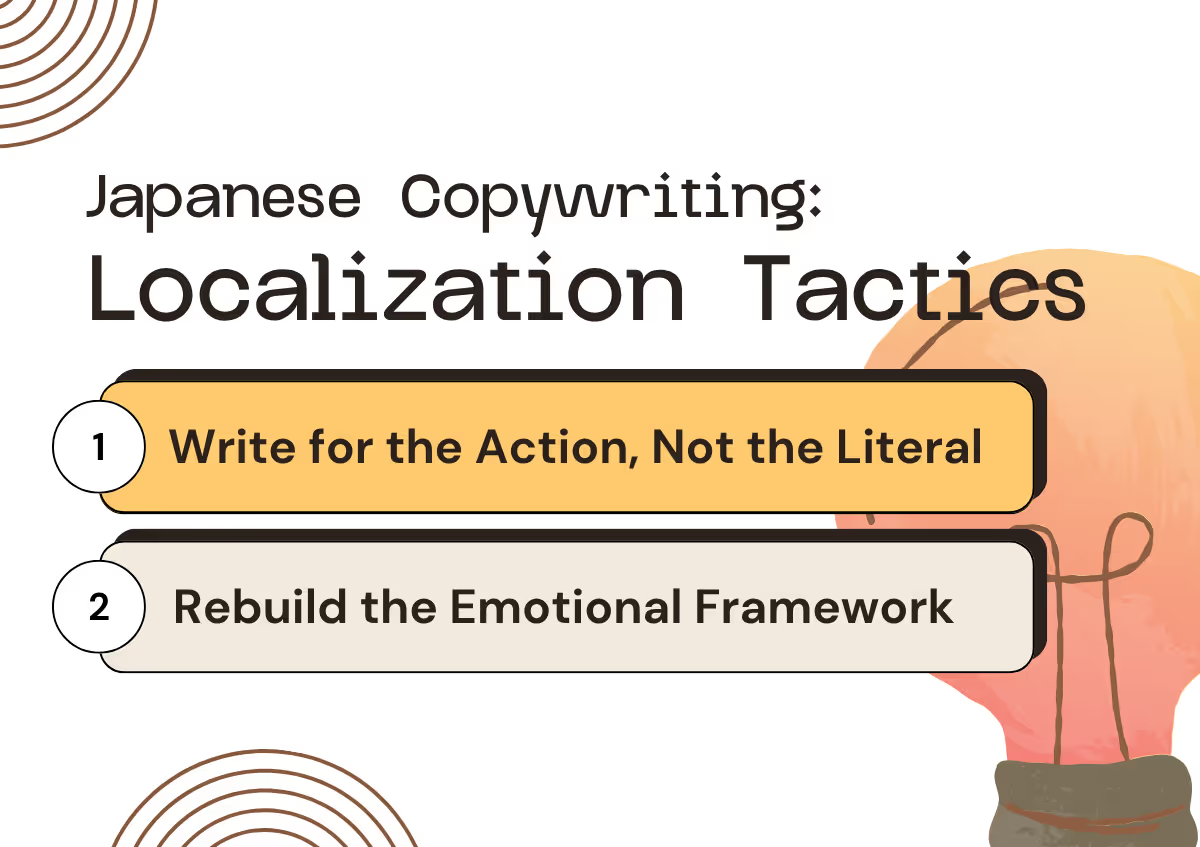
Translation is only the beginning. To build genuine connections with Japanese customers, foreign companies must move past direct conversions and develop copy that reflects local emotions, communication styles, and decision-making habits.
Effective localization goes beyond selecting the right words—it demands a careful reworking of meaning so the message aligns naturally with Japanese cultural and business norms. When the objective is to inspire action rather than simply deliver information, a deeper, more strategic approach is essential.
Below are two proven localization tactics that help drive stronger engagement in Japanese marketing.
Write for the Action, Not the Literal
Many companies translate their English CTAs directly into Japanese, losing trust, tone, and effectiveness in the process. Literal translations often sound robotic, unnatural, or even pushy. A good Japanese CTA invites the reader to take action in a low-pressure, benefit-focused, and polite way.
Common Literal Translation:
English: “Try it now”
Japanese (literal): 「今すぐ試してみてください!」
→ Too direct. Feels like a command. Lacks warmth and context.
Localized, Reader-Friendly Versions:
「今すぐ、体験してみませんか?」
(Why not give it a try now?)
「無料でお試しいただけます」
(You can try it for free.)
These versions:
- Use 丁寧語 (polite form), which shows professionalism
- Offer a gentle invitation instead of a demand
- Highlight user benefit (free, easy, no risk)
This soft yet persuasive approach is essential for Japanese B2B and consumer audiences who value modesty, calm confidence, and clarity.
Rebuild the Emotional Framework
One of the most overlooked elements in localization is emotional tone. Japanese copywriting tends to be more seasonal, contextual, and emotionally restrained compared to Western content.
To make a message resonate, it needs to feel at home in the reader’s current emotional environment. Familiar seasonal language (季語), weather-based metaphors, and references to social harmony are all effective ways to create that connection.
Seasonal Framing Example:
Let’s say you’re promoting a home heating product in winter.
Western-style line (literal): “Stay warm this winter with our new heater.”
Japanese emotional framing:「寒い季節に、あったかく過ごす知恵をお届けします。」
(Sharing warm solutions for the cold season.)
This version feels:
- Soft, helpful, and poetic
- Emotionally tuned to the reader’s seasonal experience
- Less like a sales pitch, more like advice from a trusted source
Use cases for seasonal/emotional localization:
Email subject lines:「春の新生活を応援する特集」 (Support for your spring lifestyle transition)
Website banners:「年末年始の業務をスムーズに」 (Streamline your year-end operations)
These touches may seem small, but they dramatically increase emotional relatability, which is key to getting Japanese readers to trust and act.
How to Build the Right Team for Japanese Copywriting That Converts
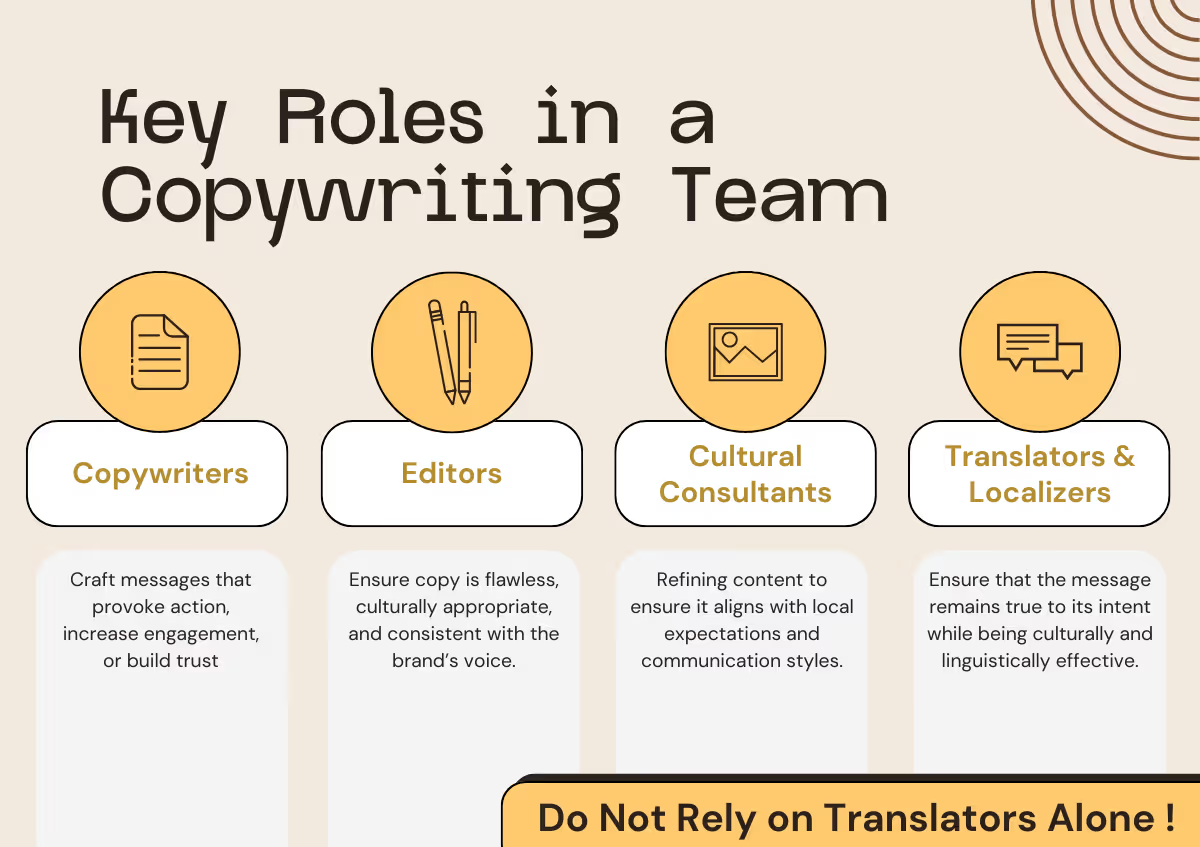
Compelling Japanese copy doesn’t come from translation—it comes from strategy. To create messaging that drives action, you need a team built for performance: copywriters who understand cultural nuance, editors who ensure clarity and tone, and specialists who know how to turn language into results.
This section breaks down the key roles you need and explains how to find the right people to make your message work in Japan.
Key Roles in a Copywriting Team
A well-structured copywriting team ensures that every aspect of clarity, engagement, and cultural alignment is addressed. The following are the essential roles in crafting compelling Japanese copy:
Copywriters: The Architects of Persuasion
A copywriter’s job is not merely to write but to craft messages that provoke action. Whether the goal is to boost conversions, increase engagement, or build trust, a good copywriter understands the psychology behind the audience’s decision-making process.
In Japanese copywriting, a skilled copywriter must:
- Adapt language and tone to align with Japan’s unique consumer expectations.
- Write with precision—Japanese consumers expect clear, structured, and respectful messaging.
- Avoid direct translations—what works in Western markets may fail in Japan without proper localization.
Companies often mistakenly believe that any fluent speaker can be a copywriter. However, copywriting is a learned skill, much like coding, graphic design, or sales strategy. The best copywriters train extensively, refine their craft over the years, and consistently produce results.
Editors: The Quality Gatekeepers
Editors polish copy to ensure it is flawless, culturally appropriate, and consistent with the brand’s voice. They focus on:
- Grammar, clarity, and coherence—ensuring the message is clear and engaging.
- Brand consistency—maintaining a unified tone across all platforms.
- Cultural appropriateness—removing phrasing that might seem unnatural or off-putting to Japanese consumers.
Japanese consumers value refinement and attention to detail, and minor errors can severely damage credibility. Having an editor ensures that the copy is compelling and aligns with Japan’s high standards for professionalism.
Cultural Consultants: The Context Experts
Even a well-written piece of copy can fall flat if it lacks cultural resonance. Cultural consultants bridge the gap between language and social expectations, ensuring that messaging:
- Resonates emotionally—leveraging cultural values like harmony, subtlety, and trust.
- Avoids unintended faux pas—phrases, humor, or expressions that might be misinterpreted.
- Uses appropriate formality—Japanese marketing often requires different levels of politeness depending on the audience.
Translators and general writers may have strong language skills, but they often lack the insight needed to tailor messaging for Japanese audiences. Cultural consultants play a crucial role in refining content to ensure it aligns with local expectations and communication styles.
Translators & Localizers: The Language Adaptation Specialists
Translation and localization ensure that the message remains true to its original intent while being culturally and linguistically effective. However, translators are not copywriters; a direct translation often fails to capture the persuasive elements necessary for marketing success.
The best approach is to pair translators with copywriters. While the translator ensures linguistic accuracy, the copywriter adapts the message for maximum impact in the Japanese market.
Do Not Rely on Translators Alone
Many companies delegate copywriting to translators, bilingual staff, or general writers, assuming fluency equals marketing skill. But copywriting—especially in Japan—is a specialized craft. It blends psychology, strategy, cultural sensitivity, and persuasive structure. Simply translating text, no matter how accurately, will rarely produce content that moves a Japanese reader to act.
A copywriter is not a translator. A translator converts language. A copywriter converts attention into action.
If you're trying to enter the Japanese market, especially as a B2B or direct-response brand, you need a Japanese-speaking copywriter who understands marketing psychology and Japanese consumer behavior. This means someone who knows:
- How to build soft CTAs that match local expectations
- How to balance emotional tone with professionalism
- How to guide readers through a logical, trust-building flow
Without this skill set, even the best translation will fall flat.
How to Vet for Copywriters
Hiring the right copywriter is as critical as hiring the right designer, developer, or strategist. You’re not looking for someone who’s simply “good at writing”—you’re looking for someone who knows how to generate results with words, and do it for a Japanese audience. In Japan, where outsourcing creative work is common, partnering with a specialist who understands both language and local market dynamics can make all the difference.
Here are key questions to ask when evaluating a Japanese copywriter or agency:
- Have you written landing pages (LPs) for Japanese B2C or B2B audiences?
Look for experience in action-driven formats—especially those that require emotional appeal and structured flow.
- Can you show performance-based results?
Ask for data or examples related to conversion rate (CVR), click-through rate (CTR), or lead generation success. An excellent copy doesn’t just sound nice—it performs.
- How do you adapt tone and CTAs for Japanese readers?
A qualified copywriter should be able to explain how they adjust:
- Level of politeness (丁寧語 vs. casual tone)
- Style of CTA (soft invitation vs. hard push)
- Structure (benefit-first language and reader empathy)
Even better, ask them to show before-and-after examples of rewritten or localized copy to increase engagement.
Practical Insights for Implementing Japanese Copywriting Strategies

Understanding the theory behind compelling Japanese copy is a solid start. But applying that knowledge to create high-converting content is where the real challenge lies, especially for small to mid-sized businesses where every word must work hard.
This section provides practical tips to help your team move beyond translation and start crafting Japanese copy that drives action, clicks, leads, and purchases. Forget high-concept branding campaigns. This is about conversion.
What Performance-Based Japanese Copy Actually Looks Like
Let’s look at how Japanese copywriting works in a direct-response, SME context—not with global brand slogans in mind but with real-world conversions in mind.
Example 1: B2B SaaS Website
Too vague (translation-style copy):
「私たちのソフトは業務を効率化します」
(Our software improves your operations.)
Effective rewrite (conversion-focused):
「面倒な経費精算を、月5時間削減。中小企業向けクラウド管理ツール」
(Cut 5 hours of expense report work each month. A cloud management tool for SMEs.)
Why it works:
- Leads with a quantifiable outcome
- Names the pain point (経費精算)
- Specifies the audience (中小企業)
- Sounds like it understands the reader’s workday, not just the product
Example 2: Online Course Landing Page
Generic CTA:
「今すぐ登録して始めましょう」
(Sign up now to get started.)
Effective rewrite:
「3ヶ月で売上アップを実現。個人事業主向けマーケ講座、受付中」
(Boost your sales in 3 months. Marketing course now open for sole proprietors.)
Why it works:
- Promises a clear outcome
- Highlights duration and pace
- Uses terms like 個人事業主 to match the target audience
Why Vocabulary Isn’t Just Language—It’s Strategy
In Japanese copywriting, word choice signals exactly who the content is intended for. Vocabulary becomes one of the most important—yet often overlooked—strategic levers in effective localization.
- Audience-Specific Language
- Teens and 20s: Use abbreviated words like カラコン (for カラーコンタクト), or use casual phrasing with soft slang and emojis on social media
- 30s–50s professionals: Expect 丁寧語, specific jargon, and reassurance through reliability language like 「実績 (Achievements)」, 「安心 (Reassurance)」, 「導入事例 (Case Study)」
- Regional nuance (Osaka vs. Tokyo): Tone shifts by location. Tokyo audiences, especially in B2B, tend to prefer formal, reserved language. In contrast, Osaka audiences often respond more positively to energetic, casual tones, sometimes even incorporating Kansai-ben
A good example of this contrast is found in recent police department recruitment posters:
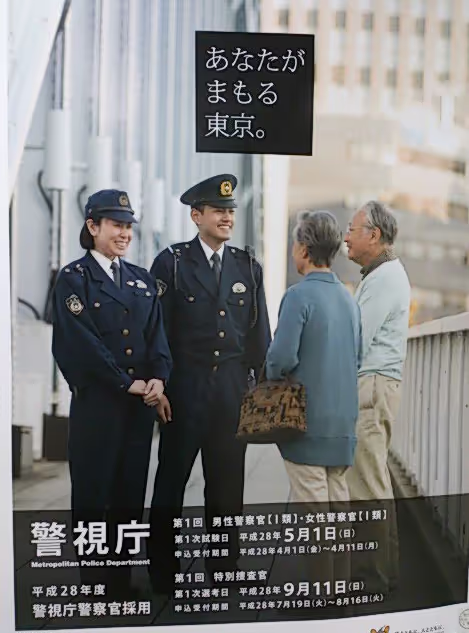
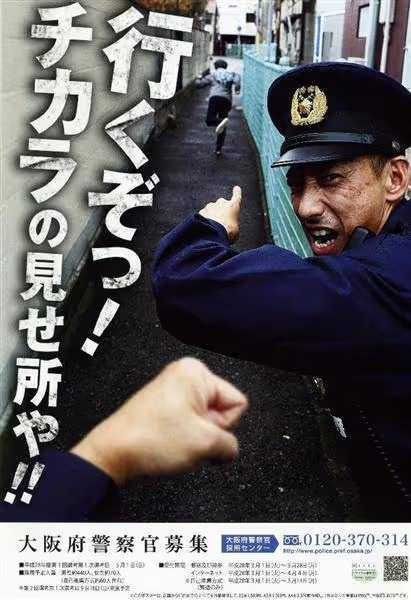
Tokyo version: 「あなたがまもる東京。」
(“You protect Tokyo.”)
A calm, civic message paired with imagery of smiling officers and elderly citizens, designed to invoke trust and responsibility.
Osaka version: 「行くぞっ!チカラの見せ所や!!」
(“Let’s go! Time to show our strength!!”)
Bold, loud, and full of local flavor, with officers running after suspects—more action-oriented and expressive, reflecting Osaka’s cultural tone.
Same goal, completely different style—because regional copy matters.
- Industry-Specific Terminology
You can’t use the same words across beauty, finance, logistics, and education. Even seemingly simple words can mean different things depending on context.
Example:
- In logistics: 「納期」(delivery lead time), 「在庫連携」(inventory sync)
- In wellness/e-commerce:「むくみ改善」(reduce swelling), 「肌のハリ」(skin firmness)
- In edtech: 「学習管理システム」(LMS), 「受講者満足度」(learner satisfaction)
Useful Tip:
Build an internal vocabulary list by:
- Reviewing Japanese competitors’ landing pages and ads
- Interviewing local partners or customers
- Collaborating with a native copywriter who understands your sector
Quick Tips for Better Execution
Rather than using general-purpose grammar tools that don’t work well in Japanese (like Grammarly), focus on tightening your internal copywriting process with these practices:
- Abbreviate when appropriate: Japanese consumers expect shorthand (e.g., スマホ, コスパ, インスタ) if it matches the demographic.
- Polish sentence flow: Use short, rhythmic sentences with natural transitions to reduce friction.
- Start with the benefit, not the product:
✖ 「AI搭載のチャットツール」
✔ 「顧客対応を自動化して、月10時間の時短を実現」
(Automate customer support and save 10 hours/month)
- Adapt CTA tone by audience:
For B2B: 「まずは無料でご相談ください」
For consumers: 「今すぐチェック」 or 「気軽に試せます」
Conclusion: The Power of Words in a Global Market
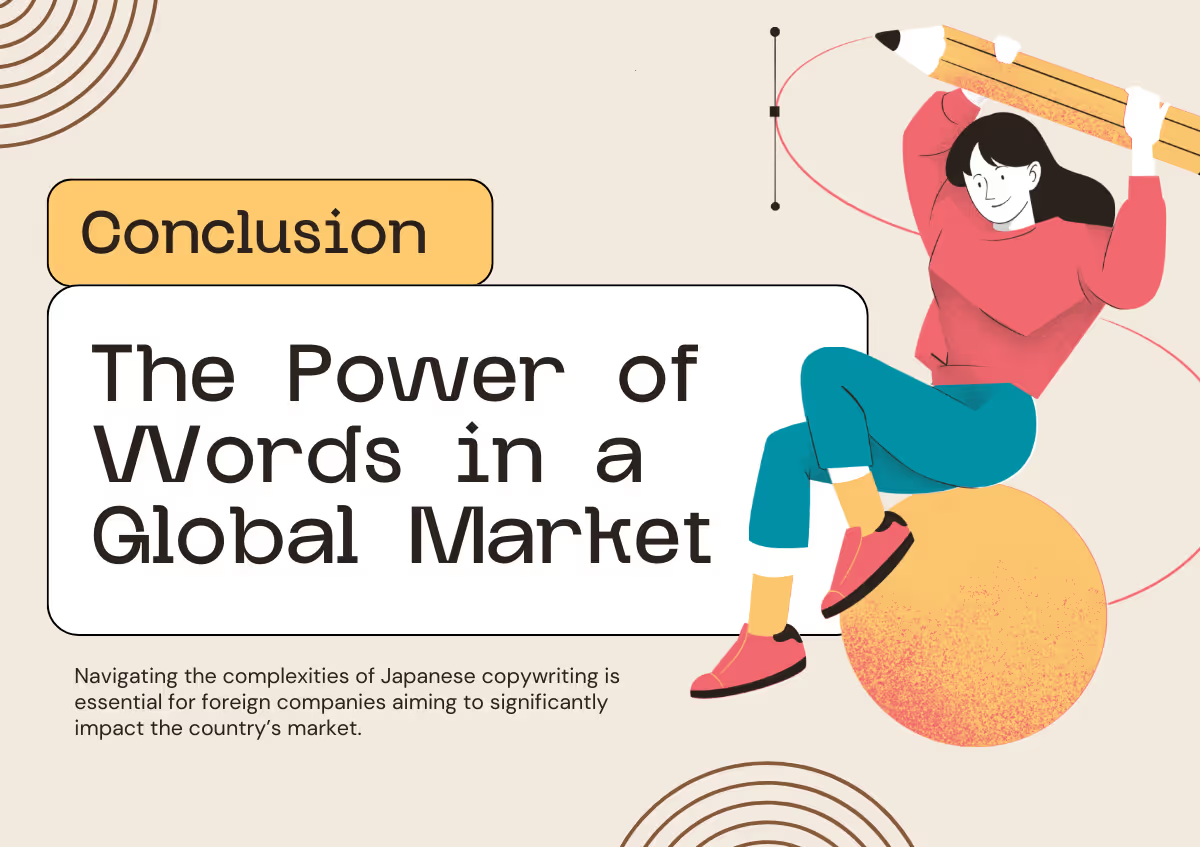
Navigating the complexities of Japanese copywriting is essential for foreign companies aiming to significantly impact the country’s market. The intricacies of the Japanese language and culture extend far beyond translation; they encompass an understanding of cultural variations, consumer behaviors, and local communication styles. From there, the importance of collaborating with local experts surfaces.
Engaging with seasoned Japanese copywriters and marketing professionals offers unparalleled insights into the subtleties of effective communication in Japan. Experts possess a profound grasp of regional dialects, consumer preferences, and cultural contexts, which is crucial for crafting messages that truly resonate with Japanese audiences. Their expertise ensures that your content is culturally relevant and engaging.
Local professionals can help avoid common pitfalls, such as misinterpreting cultural references or delivering messages that fail to align with local expectations. By leveraging their knowledge, you can create compelling, emotionally resonant content that aligns with Japanese values and preferences.
Partnering with Japanese copywriting specialists is a strategic investment that enhances your market presence and fosters deeper connections with your target audience. Their guidance will elevate the quality and effectiveness of your messaging, ensuring that your brand communicates with authenticity and impact in the Japanese market.
Key Takeaways: Why Japanese Copywriting Is a Strategic Asset
Successfully entering the Japanese market requires more than translation—it demands a strategic shift in communication. Japanese copywriting is a tool for action, trust, and connection, especially when targeting SMEs and B2B buyers.
Here’s what matters most:
- Translation is not enough. Effective copy must be rewritten, not just converted, to fit Japanese cultural logic and emotional expectations.
- Build for action. Lead with benefits, soften your CTAs, and guide users toward conversion with clarity, not force.
- Tone and structure are critical. Politeness, trust-building language, and logical sentence flow outperform direct commands or aggressive sales language.
- Localization drives results. Tailoring seasonal context, emotional framing, and user tone increases engagement and credibility.
- You need the right people. Translators aren’t copywriters. Hire Japanese-speaking professionals trained in marketing psychology and consumer behavior.
- Use the formats that work. Invest in high-converting content types like landing pages, LINE ads, and email sales letters, which are structured for action-first performance.
When you approach Japanese copywriting with intent and insight, you don’t just communicate—you convert.
Need Japanese Copywriting That Converts? Work with IGNITE
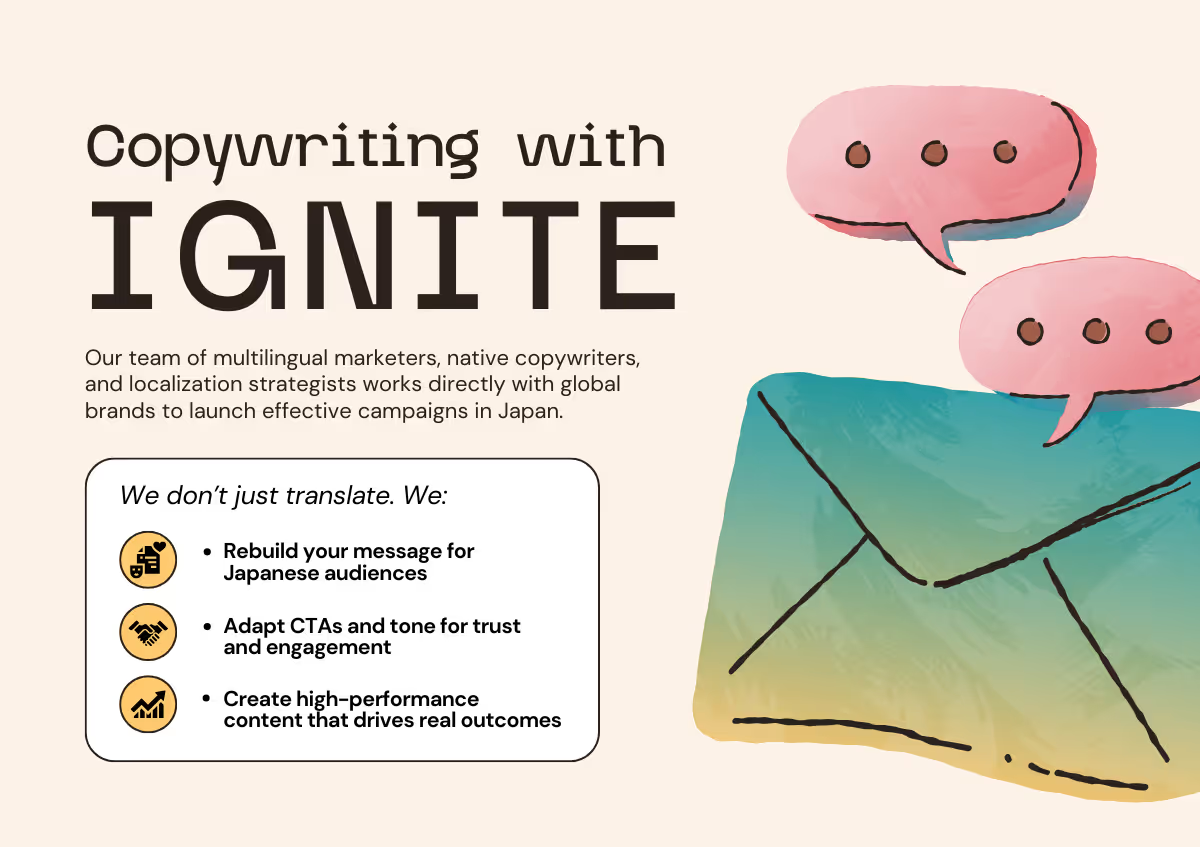
If your copywriting isn’t driving results in Japan, it’s not a translation issue—it’s a strategy issue.
At IGNITE, we specialize in crafting Japanese copy that is built to convert. Whether you need landing pages, ad campaigns, product messaging, or full-site localization, we deliver culturally tuned, benefit-focused, and action-oriented copywriting.
We don’t just translate. We:
- Rebuild your message for Japanese audiences
- Adapt CTAs and tone for trust and engagement
- Create high-performance content that drives real outcomes—leads, clicks, conversions
Our team of multilingual marketers, native copywriters, and localization strategists works directly with global brands to launch effective campaigns in Japan.
Don’t settle for “native-sounding.”
Build a copy that performs.
Contact IGNITE to create Japanese copy that works—strategically, culturally, and commercially. Let’s turn words into action.




